How can you adjust your planned learning activities to meet the needs of your learners if an unexpected event occurs? (for example, a pandemic arises and many of your employees must now work from home – how will you ensure that they can still do their jobs? What training will they need, and how will you deliver it, knowing they must remain at home?) This is a common discussion thread right now as many schools and universities have made the switch to teaching online.
First of all, I will make a new study plan for the students, and they will study by themselves in the form of online courses at home. After that, I will open up a personal meeting time to answer students’ questions. Students need to take training on computer websites. They need to learn the course materials online and how to use computer programs to do the assignments/Assignments I gave them. For the exam, I will write the questions myself, because when online, students can’t be invigilated, they may search for answers on the Internet, which is not allowed but also inevitable. I’m going to make it an open-book test, but it’s going to be a little harder.
Students will be trained to stick to their reading habits and keep up with the class each week. For online courses, strict due dates are necessary, students will not be allowed to hand in assignments or exams late.
How will your interactive learning resource specifically ensure that the needs of all learners can be met?
First, I will let students experience the course I designed, and then I will initiate a questionnaire about students’ opinions on the course design. For example, for students that have colour blind, I will make sure all the course materials are fronted black, and there will be no colourful pictures within course materials. For ELL students, I will try to use simple English words that can be easily understood by students. Students will be assigned to study groups, each of which will include at least one ELL student and several English language students. Thus, native English language students will help ELL students understand the learning material when they have trouble. Group assignments/projects will have the combinations of ELL students and native English language students instead of all ELL students. Moreover, ELL students will have a unique student group in which they will share their tips as ELL students on how to learn the course content more effectively. For single-parent students, instead of strict due dates, students will have multiple extensions which they are welcome to several days’ worth of extensions on assignments or tests. This means they can take extra days to complete a single assignment due to complex/emergency situations.
